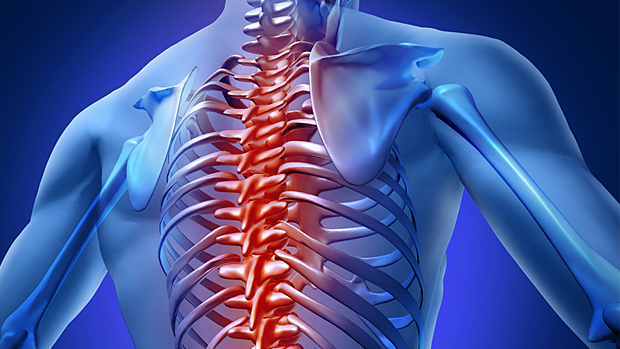The position and mobility of your thoracic spine directly affect the amount of overhead shoulder movement you have. A more erect and mobile thoracic spine and rib cage will give you greater overhead range of motion. A slouched posture or stiffness in your thoracic spine and rib cage will result in a loss of range of motion. A slouched posture will alter the position of your shoulder blade and worsen your muscle activation. Both of these problems will limit your overhead function and cause shoulder pain.
How Much Thoracic Spine Mobility Do You Need?
Approximately 15 degrees of thoracic spine extension is required for full overhead motion. This is true when performing a barbell overhead press. Full 1-arm elevation requires approximately 9 degrees of thoracic extension. Thoracic spine rotation is also crucial for rotational sports such as baseball where a large amount of your power is transferred through your trunk. A baseball pitcher who lacks thoracic spine rotation will compensate by increasing movement and stress through their shoulder and elbow.
Why You Need to Include Thoracic Spine Mobility Exercises
Strength is foundational for optimal shoulder health but thoracic spine mobility is often neglected when athletes attempt to maximize their overhead shoulder function. Therefore, exercises targeting thoracic spine extension and rotation mobility should be included in any rehabilitation or performance enhancement program seeking to optimize shoulder function. Instead of jumping to restore shoulder mobility with bands and balls, try these thoracic spine mobility exercises first.
1. Bench T-Spine Mobilization
This is my favorite exercise for restoring thoracic spine extension. It also provides a nice stretch to your lattisimus dorsi muscle which can also limit overhead mobility.
The exercise begins by assuming a kneeling position facing a bench. Place your elbows on the bench holding a PVC pipe or dowel with your palms facing up. Sit back, pushing your buttocks towards your heels, keeping your spine relaxed, until you feel a stretch in your upper back.
For an added stretch you can bend your elbows further past your head. Hold this position, and exhale fully. Reverse the motion to return to the start and repeat for 10 to 20 repetitions.
2. Thoracic Extension + Rotation (Reach Backs)
Begin this exercise by sitting back on your heels, face down, with one hand behind your head and the opposite forearm resting on the floor. This position minimizes available movement in your lower back and maximizes movement to your upper back.
From this position rotate your elbow up to the sky while exhaling. The opposite forearm remains in contact with the ground. Return to the starting position and repeat for 10 to 20 repetitions before switching to the opposite side.
3. Foam Roll Thoracic Extension Mobilization
This exercise can be challenging to perform correctly. Most end up extending through the lumbar spine and not their thoracic spine.
Begin in a lying position over a foam roll. Place your hands behind your neck supporting, but not pulling on, your neck. Raise your buttocks off the ground and roll your upper back up and down the foam roll. Identify a sensitive, stiff, or tender area and then drop the buttocks down to the ground.
From this position perform small extension movements by lifting your elbows towards the ceiling. Be careful not to overextend your lower back.
4. Thoracic Spine Windmill
This is our “go-to” exercise to restore thoracic spine rotation. Begin on your side with both arms outstretched in front of you. Place a foam roll under your top leg with your knee and hip bent to 90 degrees. Your bottom knee and hip remain extended throughout the exercise.
Reach forward with your top hand and then complete a large circular windmill motion as you rotate your entire upper body. Keep reaching as if you were attempting to lengthen your arm.
Follow your hand with your eyes to ensure proper thoracic spine and rib cage movement. Your top knee and leg should remain in contact with the foam roll throughout the exercise. Perform 10 reps and then repeat on the opposite side.
5. Standing Thoracic Rotation Mobilization
The standing rotation exercise is ideal to incorporate into a pre-workout dynamic warm-up. From a standing semi-squat position place one arm between your thighs just above your knees. This position will block unwanted hip and pelvic movement.
Next, rotate your body upwards towards the sky by following your open hand with your eyes. At the top of the movement, exhale before returning to the starting position. Perform 10 reps and then repeat on the opposite side.
Final Thoughts on Thoracic Spine Mobility
After performing these mobility drills it is important to work on strength and endurance of the thoracic muscles. Also, manual therapy to your thoracic spine and rib cage will accelerate your recovery. Maintaining or improving thoracic spine mobility is imperative for any active individual who regularly functions overhead. Manual therapy, mobility drills, and strength/endurance exercises targeting the thoracic spine will lead to significant gains in overhead function for athletes and the general population.
These 5 mobility drills can be easily integrated into any pre-workout warm-up routine or as part of a home exercise program. Call us if you want help getting started. The physical therapists at BSR have been helping people of Southern Ocean County move without pain since 2007.

